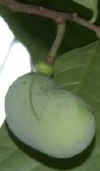| 9-29-08
There must be something transpiring in the outdoors
when paw-paws start thinking of ripening, but I don’t know what it would
be. And I would like to know what it is, if there is an old wives' tale
or some facts on the matter.
You see, paw-paws (a k a the Indiana banana) are
here to stay (like it or not--I like it) because this wild “fruit” (seedpod)
that be turned into any number of deliciously different country dishes.
The activity should be preserved, just as we preserve old buildings, noted
landmarks, or interesting and useful “things.” They are, in fact, a little-known
but integral facet of our lives – much like morel mushrooms and other natural
phenomena.
This, of course is not to say that one of the
great features of a hunt is just to stand in a cool, shady paw-paw glen
and slurp the pulp of a frost-cold fruit while you spit seeds and enjoy
the whole affair.
In short, they are icons of an area and an era.
This is precipitated, naturally, by a sashay I
made on Sunday afternoon to my favorite paw-paw patch in Boone County.
Last year had been a complete bust for me, and the year before squirrels
and raccoons (for a lack of other foods) had pilfered all of the fruit
and broken off little limbs where they grow. I had inspected my “patch”
earlier this summer to find the saplings loaded. I did not want to miss
the mysterious ripening.
While Chris Gonso, of the DNR’s Division of Forestry
(son of IU’s famed Harry Gonso, quarterback, of John Pont fame), tells
me that he has never heard of a method for aging paw-paws, he did suggest
that its almost a done deal for this year in the southern part of the state.
“Paw-pawing” in the southern counties is in the
last stages for this year, he said.
However, armed with binoculars and a lot of hope,
I found Sunday a wealth of fruit at my patch -- but no fruit had fallen;
it was all very green and solid, even the ones low enough to touch, or
pinch . . . as the Charmin.
As a tow-headed kid in good-ol Jackson County,
I would start thinking of harvesting paw-paws late in September. My interest
would peak in the last 10 days of that month, and I would start picking
them up from the forest floor when they fell of their own volition. However,
if they start taking on a coat of yellow, or black they are ripening fast.
Inside the outer shell, you will find many dark brown or black seeds--usually
close to an inch long and nearly half an inch wide. They are encased in
a lightly colored paste that is sickly sweet, but pleasant. The pulpy paste
has many culinary uses.
When buried (not real deep) the seeds sprout in
the second year, but the plants spread mostly by roots just beneath the
surface of the earth or forest humus. New growth grows very slowly.
Touch is the best way to determine ripeness. But
ordinarily, when the fruit is on the “tree” they are well out of reach.
Of course, unripe fruit will ripen in good light.
So the best way to harvest paw-paws, like persimmons,
is to pick them up as they fall. But if you shake a tree vigorously, nearly
ripe fruit will fall. I try to catch these before they hit the ground .
. . or just duck.
Bombs away!
Click on thumbnail image for enlarged view.

|

|
| The
paw-paw is known as the Indiana banana. |
Flower
of the paw-paw is half an inch wide, hangs down toward the forest floor,
and is one of our most beautiful. |
|

